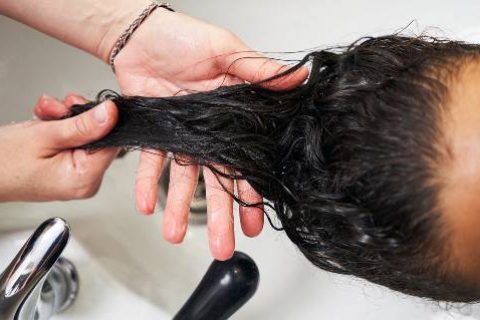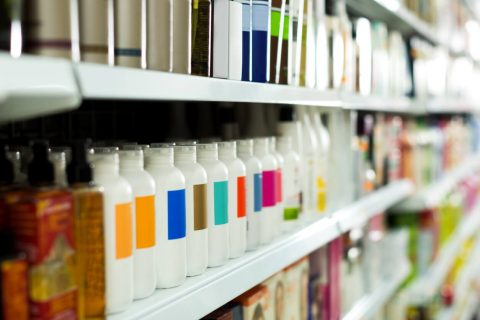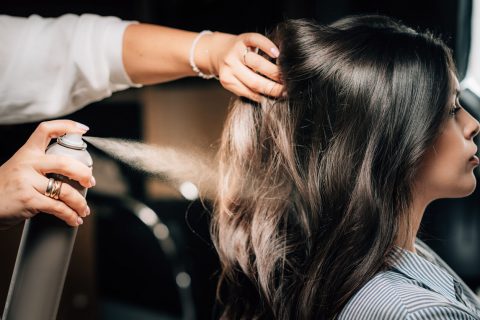17 Dangerous Ingredients to Avoid in Hair Care Products
Picture the hair care aisle at your local market. There’s no shortage of shampoos, conditioners and styling products to choose from. How do you make the best choices for your style and hair type while remembering all the dangerous ingredients to avoid in hair care products?
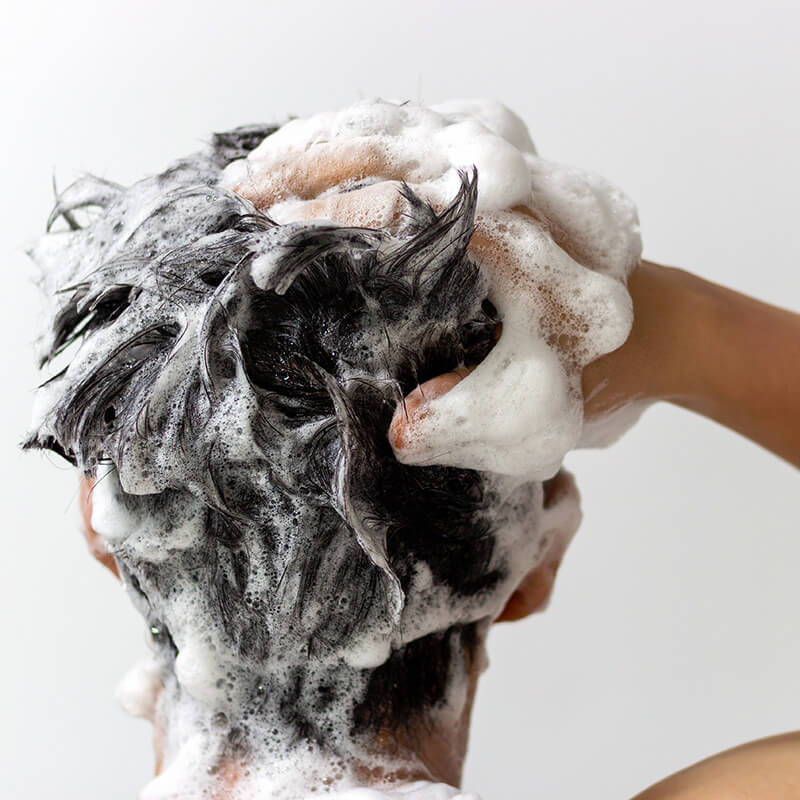
The truth is, many mass-market personal care products contain potentially harmful chemicals. By paying attention to ingredients, you can train yourself to spot these substances and find alternative products that don’t use hazardous chemicals.
In this article, we’ll dive into the 17 most common harmful ingredients found in hair care products. We’ll also delve into tips for avoiding these chemicals and some common alternatives. If you’d like to view a visual breakdown of this information, you can jump to our infographic below.
1. Sulfates
- Purpose: Shampoo lather
- Commonly found in: Shampoos
- Side effects: Skin and eye irritation, frizzy hair
Sulfates help create the lather and bubbles in some shampoos. The purpose of these surfactants, or surface acting agents, is to scrub dirt, dry skin and oil from your scalp. You might like the lathery feel of shampoos that include sulfates, but these surfactants can sometimes damage your skin, affect the texture of your hair or even trigger an allergic reaction.
- Ammonium lauryl sulfate
- Sodium lauryl sulfate (SLS)
- Sodium laureth sulfate (SLES)
Not only can these lather-boosting ingredients dry out your skin, but SLES may also have traces of the carcinogen 1,4-dioxane as a byproduct of the manufacturing stage — a chemical that has been shown to contribute to the development of cancer in lab animals.
2. Parabens
- Purpose: Preservative
- Commonly found in: Shampoos and conditioners
- Side effects: Skin irritation, suspected hormone disruption and possible carcinogens
- Methylene glycol
- Formalin
In hair care, it’s most commonly used as a vapor to give products smoothing or cleansing properties. It might also be used as a preservative in cleansing or smoothing treatments, such as keratin masks.
Formaldehyde can cause skin irritation for those with sensitive skin. You might not be aware that formaldehyde is in your hair care products, either — it’s not required to be listed on ingredient lists when it’s used to create other unique compounds during the manufacturing process, so products containing traces of formaldehyde can legally be marketed as “formaldehyde-free.”
Notably, formaldehyde is a component of many potentially dangerous chemical hair straighteners. In 2022, the Journal of the National Cancer Institute published a study identifying heightened risks of uterine cancer in women who repeatedly used chemical straighteners. An active lawsuit against L’Oreal seeks damages for the potentially harmful products.
4. Silicones
- Purpose: Preservative
- Commonly found in: Shampoos and conditioners
- Side effects: Skin irritation, suspected hormone disruption and possible carcinogens
Silicones in conditioners and hair styling products give your hair an artificially silky smooth finish. You might love the feeling of washing silicone-based products out of your hair, but they could actually be causing damage instead of repair.
- Dimethicone
- Phenyl trimethicone
- Cyclomethicone
- Cyclopentasiloxane
- Cyclohexasiloxane
Silicone can build up with repeated use. It seals your hair cuticles in a layer that prevents moisture access, meaning your hair can actually dry out over time. Silicone can also weigh your hair down and flatten curls.
5. Mineral Oil
- Purpose: Moisturizer
- Commonly found in: Curling and smoothing treatments
- Side effects: Lack of moisture and weighed-down hair
Mineral oil is a less-expensive oil used in hair products to condition and detangle. It will effectively coat your hair with a protective layer and a glossy sheen, but it works less efficiently than other oils.
Mineral oil is not able to penetrate your hair follicles and can’t actually add significant moisture to your hair or repair split or damaged ends. Instead, it works as a fast fix that isn’t long term and can actually dry out your hair with repeated use. It’s also heavy, leaving hair feeling flat instead of soft and supple.
6. Coal Tar
- Purpose: Product coloration
- Commonly found in: Hair gels and dyes
- Side effects: Cancer
Coal tar is used to dye all kinds of cosmetics. It’s a petroleum byproduct — specifically from coal processing — and like many petroleum products, it is a possible carcinogen that can contribute to the development of cancer in the lungs, digestive tract, kidneys and bladder at high concentrations. Coal tar can also contain other known carcinogens.
Because of its nature as a carcinogen, Canada and most of Europe banned coal tar for use. However, it’s still a legal additive for products in the United States.
7. Phthalates
- Purpose: Solvent, preservative
- Commonly found in: Shampoos, conditioners, styling products
- Side effects: Suspected hormone disruption and possible carcinogens
Phthalates, called the “everywhere chemical” for their prevalence, describe a large number of ingredients that modify the properties of cosmetic products. These chemicals can help dissolve other ingredients and cause them to last longer (like dyes or fragrances). In fact, most “fragrances” on ingredient lists contain phthalates.
Phthalates are currently under investigation for their effect on the human endocrine system, with research suggesting that chronic exposure may disrupt hormone signaling and cause damage to the reproductive system. They’re also banned in Canada, though they don’t need to be listed on U.S. ingredient lists. Look for “phthalate-free” products to avoid them.
Notably, researchers linked phthalates to early deaths from cardiovascular disease in approximately 100,000 older Americans.
8. Alcohols
- Purpose: Volatility, drying agent
- Commonly found in: Shampoos, conditioners, styling products
- Side effects: Skin irritation and dry hair
Spotting alcohol on your conditioner bottle ingredient list may catch you by surprise. However, alcohol is a common hair care ingredient that helps active ingredients penetrate your skin and hair. Because it’s highly volatile, it dries right after it’s applied and doesn’t leave a mess.
That same volatility means that alcohol dries out your skin and hair extremely fast. If alcohol is listed as one of the first ingredients, you should probably seek an alternative that will be less damaging to your hair and scalp long term.
9. Chemical Dyes
- Purpose: Product coloration
- Commonly found in: Styling products
- Side effects: Skin irritation
One of the first things you might picture when thinking about hair care products are the brightly colored gels and serums inside the many bottles on your shelf. While these pretty colors may look nice, they’re not necessarily safe to use on your hair.
Dyes in commercial products are typically derived from petrochemicals. Some of these chemicals were cleared for safe use by the U.S. Food and Drug Administration, while others are still being studied to determine their long-term effects.
10. Added Fragrances
- Purpose: Product scent
- Commonly found in: Shampoos and conditioners
- Side effects: Skin irritation
Your hair might smell like cherries and vanilla, but real cherries and vanilla aren’t the reason why. Fragrances are typically synthetic additions to boost the scent of cosmetic products — and they’re usually derived from hazardous petrochemicals.
Manufacturers don’t need to list the specific ingredients that make up fragrance compounds, meaning there could be a concoction of irritants or dangerous chemicals in a bottle of scented shampoo.
11. Para-phenylenediamine (PPD)
- Purpose: Hair dye additive
- Commonly found in: Hair dyes
- Side effects: Skin irritation, UV sensitivity
PPD is a chemical compound added to semipermanent and permanent hair dyes. The intense chemical can cause scalp irritation and can even increase sensitivity to UV light, raising the risk of sunburn or skin cancer.
PPD research discovered direct links between PPD application and hair dye contact allergies, with stronger ties to people who used more hair dye or applied it for longer periods of time. You can use less-damaging hair dyes that use natural colorants in place of dyes with PPD.
PPD is the subject of ongoing Just for Men lawsuits that claim the popular hair dye caused severe skin irritation and even allergic reactions that resulted in discoloration, scarring and even hospitalization.
12. Polyethylene Glycols (PEG)
- Purpose: Thickening agent
- Commonly found in: Conditioners and hair creams
- Side effects: Skin irritation
PEG is a petroleum byproduct that works as a thickening agent in hair care products. While research on the toxicity of PEG is inconclusive, scientists are looking for a link between PEG use and severe scalp irritation and skin damage.
Studies note that certain PEGs are recommended for safe use in cosmetics, while others need further study to determine their safety.
13. Triclosan
- Purpose: Antibacterial agen
- Commonly found in: Shampoos
- Side effects: Hormone disruptor
Triclosan is used in shampoo as an antibacterial agent. It was previously used in soaps until a 2016 FDA ban went into effect.
This chemical is a hormone disruptor shown to cause decreases in thyroid hormones upon exposure to high doses. Some scientists believe triclosan may also play a part in making some strains of bacteria resistant to antibiotics, meaning it might have a detrimental effect on our health, too.
14. Retinyl Palmitate
- Purpose: Boosts collagen production
- Commonly found in: Conditioners
- Side effects: Skin irritation and possible carcinogen
Retinyl palmitate is retinol infused with palmitic acid. This compound is known for its age-defying properties by helping boost skin cell turnover. As a result, it can help improve scalp health for some users. However, it carries a risk for your skin.
Retinyl palmitate can cause severe redness and irritation. Like retinol, it can also increase your skin’s sensitivity to UV rays, meaning you’re at a higher risk for sunburns and possibly skin cancer.
15. Benzene
- Purpose: Dye solvent
- Commonly found in: Hair dyes and dry shampoos
- Side effects: Weakened immune system and possible birth defects
Benzene is a petrochemical solvent used in hair dyes. It’s known to be toxic in high doses and potentially carcinogenic over long periods of time.
In addition to its possible status as a carcinogen, benzene may contribute to certain birth defects as well as immune and nervous system damage in expectant mothers. Look for ingredients labeled toluene, methylbenzene, phenylmethane and toluol.
Benzene, a known carcinogen, was found in several Procter & Gamble hair care products, leading to a P&G recall covering around 30 different products, largely aerosols and dry shampoos.
16. Resorcinol
- Purpose: Bleaching agent
- Commonly found in: Hair dyes and anti-dandruff treatments
- Side effects: Skin irritation and possible hormone disruptor
Resorcinol is an organic compound found in hair dyes used as bleaching agents and in treatments for dandruff and psoriasis.
In high doses, resorcinol can cause severe eye damage, disruption to the nervous system and breathing problems. It can also affect your endocrine system and hormone production
17. Selenium Sulfide
- Purpose: Anti-infective agent
- Commonly found in: Anti-dandruff treatments
- Side effects: Skin irritation and known carcinogen
Selenium sulfide is used in medicated shampoo to tackle the itching and flaking that accompanies dandruff and scalp irritation. This compound can be harmful in high doses or if swallowed or ingested.
Selenium sulfide is also a known skin irritant that can cause permanent hair loss. There are exposure limits, but you can opt for a natural anti-infectant like tea tree or lemongrass oil to be safe.
What To Look For in Hair Products
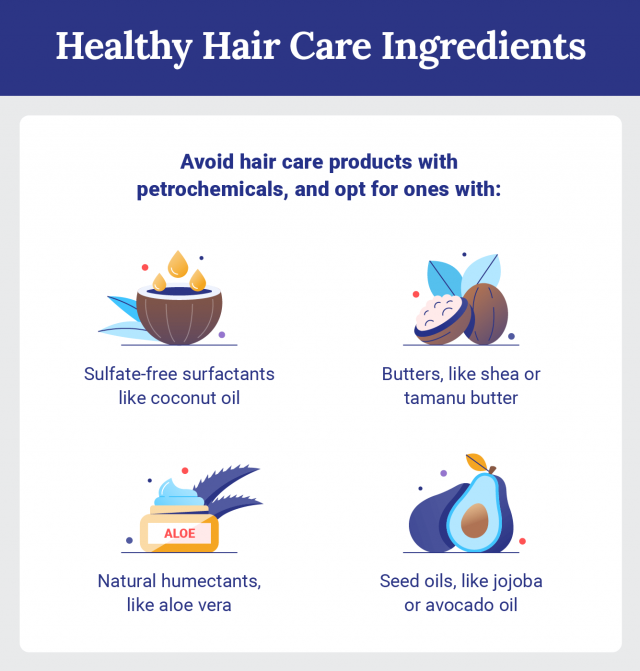
There are so many problematic hair care ingredients that it can be overwhelming to think about which ones are safe to purchase. Luckily, there are a few easy rules to remember when it comes to spotting trustworthy ingredients.
- Mild surfactants without sulfates will help boost curls without weighing your hair down, stripping it of its natural oils or causing heavy product build-up.
- Humectants such as coconut oil and aloe vera will help attract and lock in moisture while actively repairing damaged hair and split ends.
- Seed oils like jojoba and avocado oil will work to keep hair soft and add a luxurious shine, all while working to protect strands.
- Butters such as unrefined shea or tamanu butter will add moisture without clogging your pores or adding extra weight to flatten hair.
When in doubt, do a little extra research on the manufacturer’s website for a detailed breakdown of the product’s ingredients, if available. This can help you spot troublesome chemicals or irritants in advance and can also alert you to nontoxic ingredients that may trigger your individual allergies.
Get Smart About Caring for Your Hair
The product offerings in the hair care aisle are always changing. Your hair and scalp, however, are not — they’re highly sensitive and need to be protected long term from the damaging effects of harmful chemicals.
With this list of hair care ingredients to avoid, you’ll be better prepared to spot the troublemakers in the hair care aisle next time you stock up on shampoo and conditioner.

12 Cited Research Articles
Consumernotice.org adheres to the highest ethical standards for content production and references only credible sources of information, including government reports, interviews with experts, highly regarded nonprofit organizations, peer-reviewed journals, court records and academic organizations. You can learn more about our dedication to relevance, accuracy and transparency by reading our editorial policy.
- Chang, C. et al. (2022, December 8). Use of Straighteners and Other Hair Products and Incident Uterine Cancer. Retrieved from https://pubmed.ncbi.nlm.nih.gov/36245087/
- FDA.gov. (2022, March 3). 1,4-Dioxane in Cosmetics: A Manufacturing Byproduct. Retrieved from https://www.fda.gov/cosmetics/potential-contaminants-cosmetics/14-dioxane-cosmetics-manufacturing-byproduct
- Hager, E., Chen, J. & Zhao, L. (2022, February 8). Minireview: Parabens Exposure and Breast Cancer. Retrieved from https://www.ncbi.nlm.nih.gov/pmc/articles/PMC8834979/
- Wang, Y. & Qian, H. (2021, May 9). Phthalates and Their Impacts on Human Health. Retrieved from https://www.ncbi.nlm.nih.gov/pmc/articles/PMC8157593/
- Han, J.H. et al. (2018, April 23). P-Phenylenediamine Hair Dye Allergy and Its Clinical Characteristics. Retrieved from https://www.ncbi.nlm.nih.gov/pmc/articles/PMC5929949/
- FDA.gov. (2016, September 2). FDA issues final rule on safety and effectiveness of antibacterial soaps. Retrieved from https://www.fda.gov/news-events/press-announcements/fda-issues-final-rule-safety-and-effectiveness-antibacterial-soaps
- Jang, H., Shin, C.Y. & Kim, K. (2015, June 30). Safety Evaluation of Polyethylene Glycol (PEG) Compounds for Cosmetic Use. Retrieved from https://www.ncbi.nlm.nih.gov/pmc/articles/PMC4505343/
- NIH.gov. (2012, August 1). NTP Technical Report On The Photococarcinogenesis Study Of Retinoic Acid And Retinyl Palmitate. Retrieved from https://ntp.niehs.nih.gov/ntp/htdocs/lt_rpts/tr568_508.pdf
- Darbre, P.D. et al. (2004, February). Concentrations of parabens in human breast tumors. Retrieved from https://pubmed.ncbi.nlm.nih.gov/14745841/
- Bickers, D.R. et al. (2002, May 20). The safety assessment of fragrance materials. Retrieved from http://fragrancematerialsafetyresource.elsevier.com/sites/default/files/AB-2-Bickers-Safety.pdf
- NIH.gov (n.d.). Selenium Sulfide. Retrieved from https://medlineplus.gov/druginfo/meds/a682258.html
- NIH.gov. (n.d.). Resorcinol. Retrieved from https://pubchem.ncbi.nlm.nih.gov/compound/Resorcinol
Calling this number connects you with a Consumer Notice, LLC representative. We will direct you to one of our trusted legal partners for a free case review.
Consumer Notice, LLC's trusted legal partners support the organization's mission to keep people safe from dangerous drugs and medical devices. For more information, visit our partners page.
844-420-1914